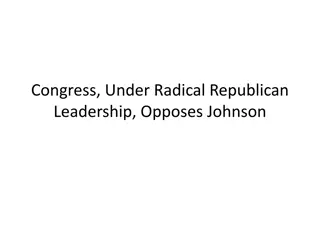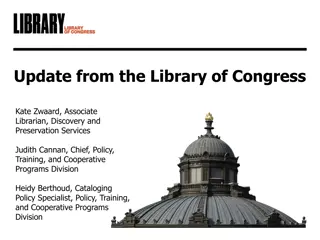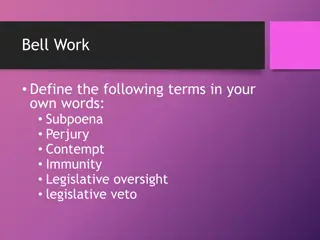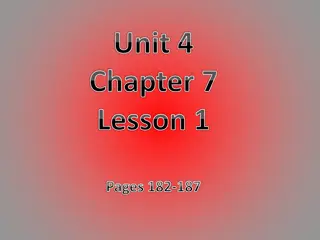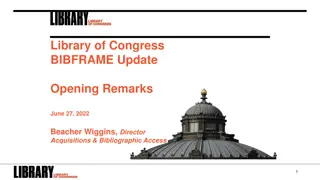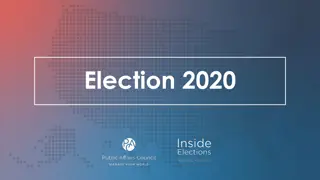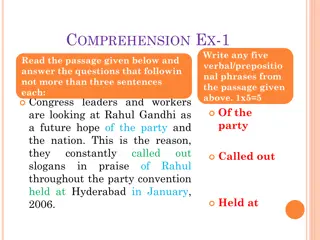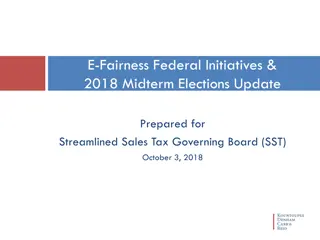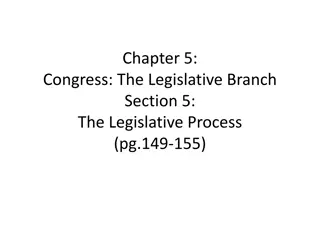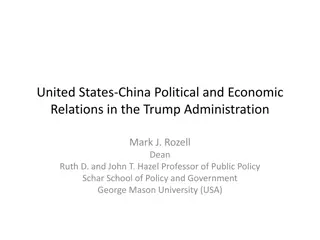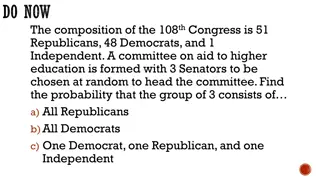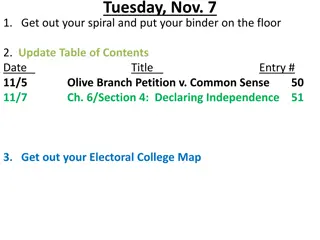Insights into the Power of the American Congress
The American Congress, established by the Constitution, holds significant power due to its role in overseeing the budget, introducing legislation, confirming nominations, and declaring war. Its authority to tax and spend gives it control over the nation's finances. The presidential system further enhances Congress's power by maintaining a separation of powers between the executive and legislative branches. This system promotes autonomy and prevents either branch from dominating the other, contributing to the Congress's influence as a key legislative body in the world.
Download Presentation

Please find below an Image/Link to download the presentation.
The content on the website is provided AS IS for your information and personal use only. It may not be sold, licensed, or shared on other websites without obtaining consent from the author. Download presentation by click this link. If you encounter any issues during the download, it is possible that the publisher has removed the file from their server.
E N D
Presentation Transcript
The Congress Marilena Simiti
Established by Article I of the Constitution, the Legislative Branch consists of the House of Representatives and the Senate, which together form the United States Congress. The Congress
The Congress The American Congress remains the most influential legislature in the world.
Why is American Congress so powerful? 1)The Constitution: The framers of the Constitution clearly intended that Congress would be the cornerstone of the new republic. A leading role for the legislature was judged an essential defense against executive tyranny; the list of powers which the constitution awards to Congress is longer and more detailed than that given to the President. Madison, an architect of the American constitution, declared that in republican government, the legislative power necessarily predominates . Thus, Article I of the Constitution grants several key powers to Congress, which include overseeing the budget and all financial matters, the sole power to introduce legislation, confirming or rejecting judicial and executive nominations by the President, reviewing and monitoring other bodies such as the executive branch, and even declaring war
According to the Constitution the Congress has the power to tax and spend. This power is among the most important powers Congress possesses. It gives Congress what is typically referred to as the power of the purse . This means Congress controls the money. Thus, Congress has final authority over the budget. However, its proposal is subject to a presidential veto. Why is American Congress so powerful
Why is American Congress so powerful? 2) Presidential System: Presidentialism is a form of constitutional rule in which the chief executive governs using the authority derived from direct election, with an independent legislature. Because both president and legislature are elected for a fixed term, neither can bring down the other, giving each institution some autonomy. This separation of powers (executive and legislative powers) is the hallmark of the presidential system and is typically reinforced by a separation of personnel. Members of the executive cannot sit in the assembly, creating further distance between the two institutions. Similarly, legislators must resign their seats if they wish to serve in the government. In essence, the presidential system separates the executive and legislative powers.
Presidential System Presidential government consists of three features: 1. Popular election of the president who directs the government and makes appointments to it 2. Fixed terms of offices for the president and the Congress, neither of which can bring down the other. 3. No overlap in membership between the executive and the legislature.
Parliamentary System While presidents in the presidential system are separate from the assembly and independently elected, the executive in parliamentary systems is organically linked to the legislature. The government emerges from the assembly and can be brought down by a vote of no confidence. By the same token the government can dissolve parliament and call fresh election.
Parliamentary System Parliamentary government has three main features: 1. The governing parties emerge from the assembly. Government ministers are usually drawn from, and remain members of, the legislature. 2. The head of the government (called Prime Minister or Chancellor) and the council of ministers (called the Cabinet) can be dismissed from office through a vote of no confidence by parliament. The post of Prime Minister is separate from that of a ceremonial head of state (President or King/Queen) 3. The executive is collective, taking the form of a cabinet. This plural executive contrasts with the focus in presidential government on a single chief executive (the President).
In the case of parliamentary systems if a ruling government retains a strong and secure majority in the Parliament and party discipline is enforced, the executive can easily dominate the legislature. In this case government s survival is not threatened by Parliament and the government can easily pass the legislation it proposes. Parliamentary System
American Presidential System In the American political system President and Congress share power: each seeks to influence the other, but neither is in any position to dictate. This separated system, reflects a successful attempt by the founders to build checks and balances into American government. However, in the American political system the prospect of political stalemate is built into the American legislative-executive process. For example, there might be a Republican in the White House and Democrats controlling the Senate and the House of Representatives. That may lead to policy gridlock.
Divided- Unified Government Divided government occurs when one or more houses of the legislature are controlled by the party in opposition to the executive. Unified government occurs when the same party controls the executive and the legislature entirely
The Legislature When a legislature has one chamber, we speak of a unicameral legislature (unicameralism) When a legislature has two chambers we speak of a bicameral legislature (bicameralism). In bicameral legislatures, the first or lower chamber is typically called the National Assembly or House of Representatives. The second or upper chamber is usually known as the Senate.
In all federations the federal units (e.g., states, cantons) have a guaranteed voice in national policy-making through an upper chamber of the assembly. In that chamber each state normally receives equal, or nearly equal, representation. The American Senate, with two senators per state, is the prototype. With its constitutional position as representative of the states, the Senate plays a full part in the country s legislative process. Accordingly, the bicameral American Congress seeks to balance the effects of popular majorities with the interests of the states. Federations - Bicameralism
The American Congress The American Constitution gives the Congress a bicameral but interconnected design. Article 1, section 7 of the Constitution requires them to work together to produce legislation. Both the House and the Senate must pass a bill in the same form for it to become law. There are further provisions that connect the two chambers together. For instance, the House of Representatives is responsible for deciding the impeachment of a President. The Senate is responsible for the trial of the President. In brief, both legislative bodies matter and are co-equal. On the other hand, there are clear differences between the two legislative bodies regarding size, terms of office, size of constituency and constitutional responsibilities. For instance, only the House can originate revenue legislation, and only the Senate confirms presidential nominations and approves treaties. Finally, each branch creates its own rules and organization.
American Congress -Senate (upper chamber) The Constitution specifies that every state will have two senators who each serve a six-year term. Therefore, with fifty states in the Union, there are currently one hundred seats in the U.S. Senate. Senators were originally appointed by state legislatures, but in 1913, the Seventeenth Amendment was approved, which allowed for senators to be elected by popular vote in each state. Senators terms are arranged so that about one-third of the Senate is up for reelection every two years Senate Direct popular vote in each of 50 states, Length of term: 6 years, Limit in Reelection: No limits
In addition to full legislative authority, the U.S. Constitution provides the Senate with two unique responsibilities: first, the power to confirm certain presidential nominees to the federal judiciary and certain executive branch positions; and second, the power to approve treaties. The Constitution requires that two- thirds of voting Senators agree for a treaty to be ratified. Most presidential nominations are referred to the relevant Senate committee of jurisdiction. Prior to potential committee action to report a nomination, a committee may hold a hearing at which a nominee answers questions from the committee s members. His or her confirmation requires only a simple majority vote. American Congress -Senate (upper chamber)
The House of Representatives has several powers assigned exclusively to it, including the power to initiate revenue bills, impeach federal officials, and elect the President in the case of an Electoral College tie. American Congress- House of Representatives (lower chamber)
American Congress -House of Representatives (lower chamber) The House of Representatives is larger than the Senate, with 435 elected members. Seats in the House of Representatives are distributed among the states based on each state s population. Each state is divided into several single-member districts according to its population. States with larger populations are divided into more numerous single-member districts. Accordingly, more populous states have more representatives in the House. Because of this system, representatives in the House generally have fewer constituents than do senators. Members of the House are elected every two years. House of Representatives Direct popular vote in each of 435 districts, Length of term: 2 years, Limit in Reelection: No limits
2022 United States House of Representatives elections Partisan composition, U.S. House 118th Congress Party Members Democratic 213 Republican 221 Vacancies 1 Total 435
House of Representatives - Election Since elections for the members of the House of Representative take place in single-member districts, the candidate who receives the greatest overall number of votes wins. Winner-take-all elections with one representative elected for one district allow voters to develop a personal relationship with their representative to the government. But winner-take-all elections also tend to limit the number of people who run for office. Since voters do not like to waste votes, candidates of third parties must convince voters they have a real chance of winning races before voters will take them seriously. Third parties that appeal to only a small percentage of voters will always lose to a party that is more popular. Therefore, analysts argue that the existing winner-take-all elections favor and strengthen the established two- party system.
House of Representatives Drawing Electoral districts Federal law requires states with more than one representative to draw numerous individual districts. Federal law requires that these districts must be as equal in population as possible. The federal law also requires the creation of districts where minority groups comprise most of the district population where possible. Electoral district boundaries must be redrawn at least every decade according to the population and demographic changes recorded by the United States Census. However, state legislatures are free to draw the boundaries as they please, keeping in mind the population and minority requirements. Redistricting can have a decisive effect on who is elected in the House of Representatives.
House of Representatives - Gerrymandering The term gerrymandering refers to districts deliberately drawn is such a way to disadvantage a certain group of people (e.g., racial, ethnic minorities) or political party and privilege another. Historically, this was one method of disenfranchising African Americans. Concentrations of African Americans were divided between districts to prevent any district majorities (this method is known as cracking ). Today federal law prohibits racial/ethnic cracking . As United States have become more politically polarized, partisan gerrymandering has become increasingly common. States controlled by one party will draw districts to advantage their own party. Some states to overcome the danger of gerrymandering have turned to independent districting commissions (e.g. Arizona, California, Montana)
The incumbency effect Incumbents are elected officials who currently hold an office. Modern political campaigns in the United States are expensive, and they have been growing more so. For example, in 1986, the costs of running a successful House and Senate campaign were $849,111 and $7,243,782, respectively (in 2020 dollars). By 2020, those values had shot to $2.4 million and $27.2 million. The amount of money that incumbents raise against their challengers demonstrates their advantage. This is one of the many reasons incumbents win a large majority of congressional races each electoral cycle.
The incumbency effect In the House, the percentage of incumbents winning reelection has been over 85 percent for the last half century. The difficulty of unseating an incumbent in the House or Senate is often referred to as the incumbent advantage or the incumbency effect. The advantage in financing is a huge part of this effect, but it is not the only important part. Incumbents often have a much higher level of name recognition. Voters are far more likely to select the name of the person they recall seeing on television than the name of a person they hardly know. And donors are more likely to want to give to a proven winner. Also, political parties in general prefer to support incumbents in elections, because the general consensus is that incumbents are better candidates. Finally, incumbent members of Congress have paid staff, influence, and access to specialized information that can help their constituents in ways other persons cannot. On the other hand, significant changes in public opinion may affect the incumbency effect. For instance, in the political environment of 2014, when conservative voices turned further to the right, House majority whip Eric Cantor (highest-level Republican representative) failed to be reelected.
The incumbency effect refers to the electoral bonus sitting members enjoy, arising from their visibility in their district, their ability to deliver specific benefits to their home districts and their access to resources for their re-election campaign. The incumbency effect helps to explain the high re-election rate in the American Congress. The incumbency effect
Bringing home the bacon or pork-barrel politics: as a term pork-barrel politics refers to federal spending on projects designed to benefit a particular district or set of constituents. In practice it means securing funds for a specific district s project like an airport or getting tax concessions for certain types of agriculture or manufacturing. Pork- barrel Politics
Representation Congress Lawmaking Oversight and monitoring the executive branch
Congress - Representation By definition Senators and House members are representatives. This means they are intended to be drawn from local populations around the country so they can speak for and make decisions for their constituents. Two fundamental questions can be posed regarding representation: 1) Should Congress share the same demographic characteristics as the public, look like the public? (descriptive representation), 2) Should the role of representatives be that of a delegate or a trustee?
Descriptive Representation In the past, there was relatively little concern about descriptive representation in Congress. A major reason was that until well into the twentieth century, White men of European background constituted an overwhelming majority of the voting population. African Americans were routinely deprived of the opportunity to participate in democracy, and Hispanics and other minority groups were fairly insignificant in number. While women in many western states could vote sooner, all women were not able to exercise their right to vote nationwide until passage of the Nineteenth Amendment in 1920, and they began to make up more than 5 percent of either chamber only in the 1990s.
Descriptive Representation In recent decades, Congress has become much more descriptively representative of the United States. The 117th Congress, which began in January 2021 had a historically large percentage of racial and ethnic minorities. African Americans made up the largest percentage, with fifty-seven members, while Latinos accounted for forty-seven members, up from thirty just a decade before. Still, the diversity of the country is not reflected in the U.S. Congress, whose membership (following the 2020 elections) was approximately 76 percent male, 77 percent White, and 88 percent Christian
Delegate vs Trustee A second question concerning representation is what the role of the legislator as a representative should be. Representatives who see themselves as delegates believe they are empowered merely to enact the wishes of constituents. They are not permitted the liberty of employing their own reason and judgment while acting as representatives in Congress. This is the delegate model of representation. In contrast, a representative who understands their role to be that of a trustee believes they are entrusted by the constituents with the power to use good judgment to make decisions on the constituents behalf. This is the trustee model of representation.
Understandably, few if any representatives adhere strictly to one model or the other. Instead, most find themselves attempting to balance the two models. Usually, representatives remain firm in support of some ideologies and resistant to others. On the political right, an issue that demands support might be gun rights; on the left, it might be a woman s right to an abortion. For votes related to such issues, representatives will likely pursue a delegate approach. For other issues, especially complex questions, such as subtle economic reforms, representatives will tend to follow a trustee approach. Delegate vs Trustee
The House has a constitutionally specified presiding officer the Speaker who is elected by a majority vote of the entire House. The vote is traditionally a party-line vote, so the Speaker is always a member of the majority party. As a testament to the importance of the Speaker, since 1947, the holder of this position has been second in line to succeed the president in an emergency, after the vice president. The Speaker has the authority to assign bills to committees. The Speaker also chooses the chairperson and the majority-party members of the powerful House Rules Committee, which controls the scheduling of bills. Moreover, the House Rules Committee, which is controlled by the Speaker, has the power to enforce formal limits on floor activity debating and amending bills. House of Representatives- Organization
In the House every bill gets a rule from the Rules Committee before it is scheduled for floor action by the entire chamber. The rule may place limits on floor debate and amendments. These abilities make the Rules Committee a very powerful force in the House. House of Representatives- Organization
In contrast the Senate doesnt have a Speaker. According to the Constitution, the Senate s president is the elected Vice President of the United States. The Vice President is empowered to preside over Senate deliberations at any time but may not vote except to cast a tie-breaking vote (in case of an equal number of votes). The Senate majority leader s position is less powerful than that of the House Speaker. Unlike the House, where the Speaker directs the floor debate, the Senate has a tradition of unlimited debate. Any senator who wishes to speak on a bill can do so and for any length of time. Moreover, the Senate allows its members to propose amendments to any bill, even if these amendments are not closely related to the bill s content. Senate- Organization
Senate Accordingly, coordination of the Senate s business emerges from constant negotiations between the party leaders, the majority and minority leaders. They spend every legislative day negotiating temporary interparty contracts.
Each party in each chamber has its own leadership that coordinates party policy positions (majority and minority leaders). Below these leaders are the two party s respective whips. A whip s primary duty is to enforce voting discipline in the chambers. Party Leadership - Congress
Committees Committees are actually mini-legislatures that divide up the workload of Congress. In both chambers policy expertise resides in the standing committees consisting of members from both parties that typically take the lead in developing and assessing legislation. At present there are 20 standing committees in the House and 16 in the Senate. Standing committees are permanent. All committees are chaired by a member of the majority party, though chairs often work closely with the committee s ranking member, the most senior member of the minority party on the committee. In almost all cases, the ratio of majority party to minority party members on a committee roughly reflects the overall partisan ratio in the congressional chamber.
Standing Committees Each standing committee has legislative authority in that it can draft, and rewrite proposed legislation and can recommend to the full chamber the passage or defeat of the bills it handles. These are substantial sources of power that legislative committees in some democracies don't have. Their role is limited to advising party leaders on policy issues. Most of the standing committees have subcommittees, each of which has a defined jurisdiction.
Committees (Standing Committees - Examples) House Senate Agriculture Appropriations Armed Services Budget Education and Labor Energy and Commerce Ethics Financial Services Foreign Affairs Homeland Security House Administration Judiciary Natural Resources Oversight and Reform Rules Agriculture, Nutrition, and Forestry Appropriations Armed Services Banking, Housing, and Urban Affairs Budget Commerce, Science, and Transportation Energy and Natural Resources Environment and Public Works Finance Foreign Relations Health, Education, Labor, and Pensions Homeland Security and Governmental Affairs Judiciary Rules and Administration Small Business and Entrepreneurship Veterans' Affairs
Four Types of Committees Standing: Permanent and focus on legislating. They contain only members of one chamber Select: They are temporary and generally used to investigate issues that do not fit neatly into any standing committees. They contain only members of one chamber. Joint: They may be permanent or temporary and are generally advisory. They exist to coordinate policy between the House and Senate. As such, they contain members from both chambers Conference: They are created, whenever needed, solely to resolve differences between House and Senate versions of a single bill. They contain members from both chambers (usually members from the standing committees that developed the bill).
Example of Select Committee The Select Committee Investigating the January 6th Attack on the United States Capitol: The committee called (subpoena) senior members of the Trump administration and the Republican leadership in Congress to testify in an attempt to learn more information about the president's activities as the Capitol assault was unfolding. The committee also aims to delve into right-wing groups that planned the demonstrations and whose members took part in breaching the Capitol. For instance, Steve Bannon (ex-Trump adviser) defied a summons from the select committee and the House of Representatives voted to hold Steve Bannon in contempt of Congress, leading to his prosecution.
The Process by which a Bill becomes Law
The process of creating laws is often referred to as labyrinth-having lots of twists and turns where proposals can and do disappear. Moreover, the process by which a bill (meaning a proposed legislative act) becomes law is rarely predictable and can vary significantly from bill to bill
In the House, bills are referred by the Speaker, to all committees that have jurisdiction over the provisions in the bill. In the Senate, bills are first submitted to the office of the majority leader who will, in consultation with the minority leader, refer the bill to one or more committees in a similar process. Introduction and Referral of Bills
Committee Consideration The first formal committee action on a bill or issue might be a hearing, which provides a forum at which committee members and the public can hear about the strengths and weaknesses of a proposal from selected parties like key executive branch agencies, relevant industries, and groups representing interested citizens. The committee agrees by majority vote if a bill should be reported to the chamber (meaning if it is eligible for floor consideration).
House Floor In the House, each and every bill gets a rule from the Rules Committee before it is scheduled for floor action by the entire chamber. The rule may place limits on floor debate and amendments. The Rules Committee may enact stricter limits on debate (all the way down to no debate at all),and may place limits on amending (all the way down to no amendments at all) as well. These abilities make the Rules Committee a very powerful force in the House. The final vote requires a simple majority for approval of the bill.







